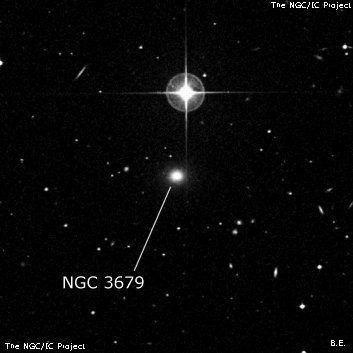
William Herschel discovered NGC 3679 = H III-112 on 24 Apr 1784 (sweep 205) and recorded "cL, eF, R, r. Just preceding, and very near a B star. The nebulosity touches the star. There is so much moonlight that I do not see it satifactory, and am, even not without some doubts as to the reality, but must defer the verification till a darker night." There is nothing near his position.
Dreyer notes that WH could not find this nebula again on 29 Dec 1786 (sweep 673). He reported "Looked for the Nebula III. 112 and though the night is apparently not a bad one, I could not find it. I examined a great part of the heavens in this neighborhood but saw nothing of it." He searched again unsuccessfully on 20 Mar 1789 (sweep 912), but found another nebula - probably MCG -01-29-021 - "making a trapezium with 2 small stars". The RNGC and PGC (as well as secondary sources such as Megastar) identify this galaxy as NGC 3679. But there is no bright star near MCG -01-29-021 matching the original description and Dreyer concludes that III-112 is probably nonexistent. NGC 3915 = H III-113, the next object found in the sweep, also cannot be identified with any confidence.
See Harold Corwin's discussion of these identities. He suggests that NGC 3679 might be MCG -01-29-012, located 2.4' south of of mag 7.8 HD 98750. My visual description refers to (R)NGC 3679. Interestingly, Spitaler also identified this galaxy as NGC 3679 in an 1892 observation and measured an accurate position.
400/500mm - 18" (3/19/04): fairly faint, small, elongated 5:2 N-S, 0.7'x0.3', fairly even surface brightness. Three mag 14 stars are within 2'. Located 4.6' SSE of a mag 10 star. The NGC identification is very uncertain and NGC 3679 may apply to MCG -01-29-012.
Notes by Steve Gottlieb